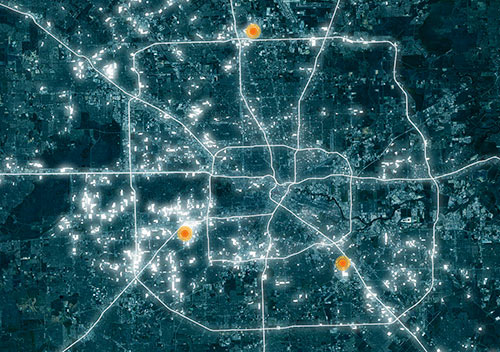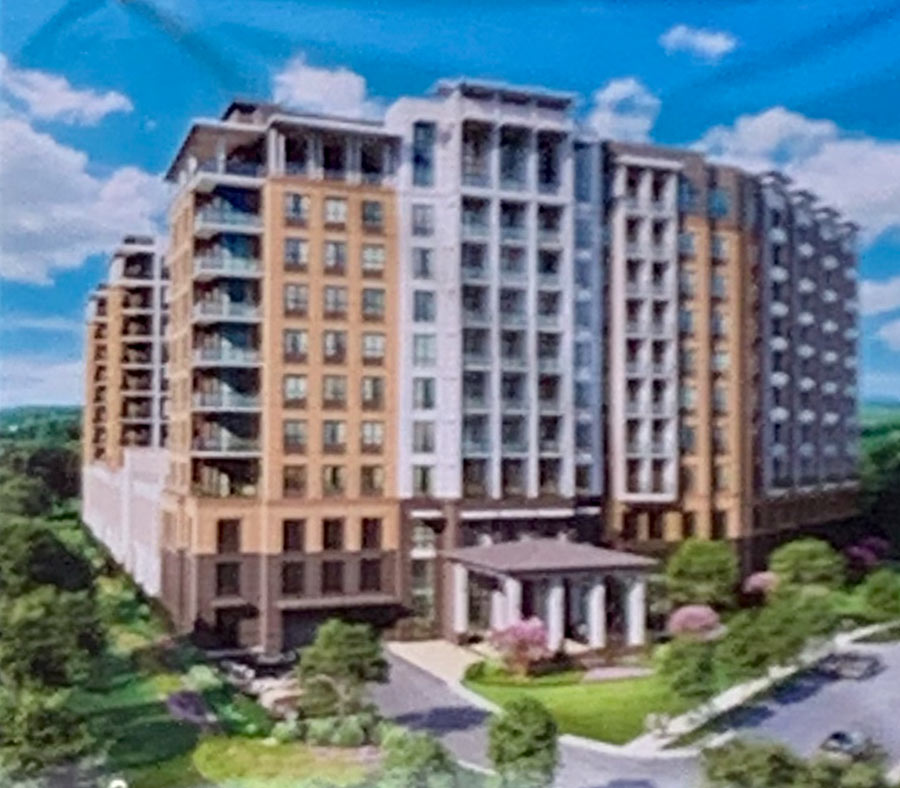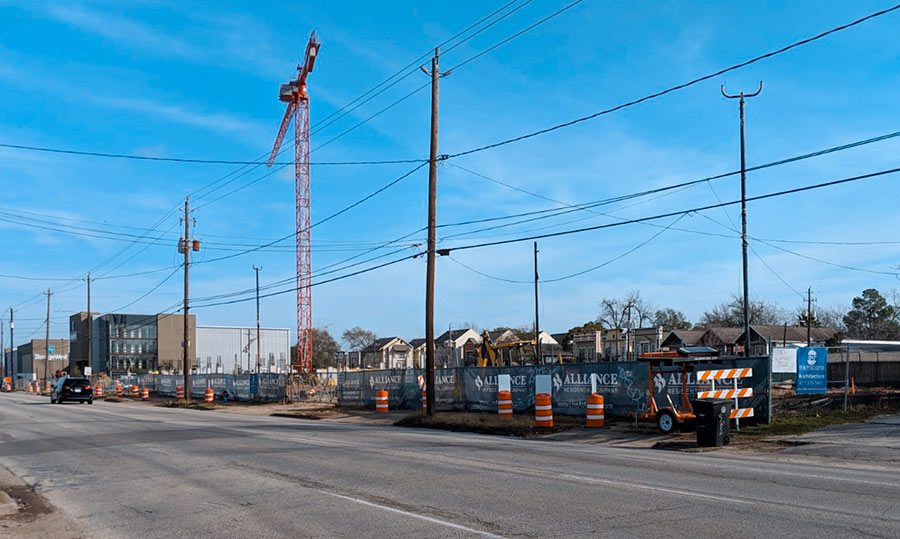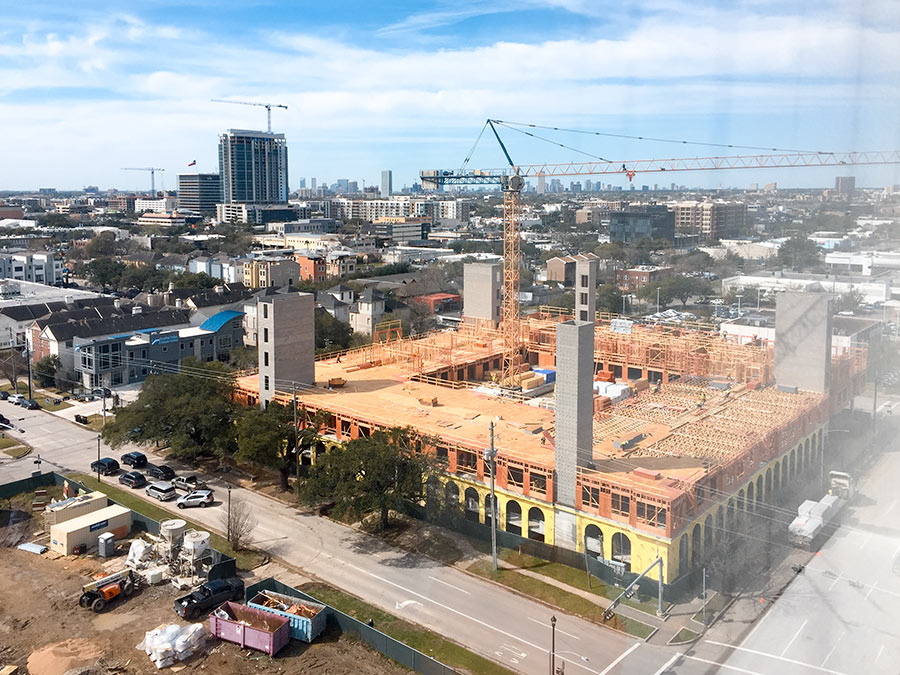
Before delving into the communities residents have built for themselves at the St. Cloud apartment complex on Hillcroft in Gulfton, Thai Xuan Village on Broadway near Hobby Airport, and Greenspoint (each marked in orange on the map), UH architecture prof Susan Rogers tries to present the big picture of Houston’s multifamily situation — accompanied by the above heat map showing (according to HCAD land-use data) where the apartments are: “315,357 is the number of multifamily apartments housed in buildings comprised of 10 or more units. Forty percent of this housing, or just over 140,000 units, were constructed between 1960 and 1979. Today, this housing is home to more than 20 percent of Houston’s two million residents. The units are dispersed in roughly 600 separate complexes, with an average of 250 units, and typically constructed at densities of 30-40 units per acre. Not surprisingly, the new projects are located predominantly outside the Loop and many are in a downward spiral of disinvestment.”
Map: Rose Lee





Houston’s version of Housing Projects. Did really need a commissioned study on this? Any Houstonian that has lived here more than a decade is well aware of where these are, when they were built, why, what happened to them, and what they’ve become…it’s Houston’s cautionary tale to any fast growing city.
The linked article is interesting, particularly the detail of Thai Xuan Village which so many of us pass by on our way to and from Hobby. But I wonder why she didn’t find one particular Greenspoint apartment complex to compare with the two other complexes. it’s not an apples-to-apples comparison.
It’s basically what I’ve been saying all along. These old apartment complexes are Houston’s affordable housing, and we certainly don’t have a shortage of it. Anyone who says we do is either ignorant of the situation, has ulterior motives, or both.
.
It makes absolutely no sense to go out to Katy or Spring and use tax credits to build new affordable housing. That’s the urban equivalent of buying a new car and leaving the old one to rot on your front lawn. What we need is to reinvest in the kind of apartments that Susan Rogers identified. Complexes with a strong community, like St. Cloud and Thai Xuan village should be empowered with Community Development Block grants to invest and make improvements. Complexes without communities like those should be bought up by good investors who use tax credits to completely rehabilitate or reconstruct them.
.
In short, let’s fix what we have before we go off and build more affordable housing. As Susan Rogers pointed out there is ALOT to do.
I agree ZAW, let’s keep this “affordable housing” preferably inside the loop, or at least inside the beltway. Nothing guarantees neighborhood decline like affordable housing and a Metro stop.
Ok, speak slowly to me. Define “downward spiral of disinvestment”.
The number one reason for homelessness is lack of affordable housing. Many cities have building codes that a percentage of new units be ‘affordable housing’. The intent is to not displace all residents during gentrification, which is running rampant here.
ZAW, do you know how dangerous some of these areas are she’s identified. Yes, perhaps it’s affordable, but really, would you want to live there? Yeah, exactly. I think we have a need for affordable housing for young professionals now making 100000+, but they need to be safe. You can’t say to young professionals–hey come to Houston, we have affordable housing, though you may get robbed, home invaded and pistol whipped, it’s at least affordable.
Not* not now*–I really loath iphone autocorrect.
I don’t know what the office occupancy rate is for Greenspoint, but needless to say once EXXON vacates there the market price per square foot will drop. I do know that it reached a critical level several years ago, no business wanted to lease in the area due to the high crime rate. I don’t know if that’s improved, my spidey sense tells me the stigma of Greenspoint being a demilitarized zone still remains.
Moreover, the denizens living in those multi-family housing developments are wholly ignorant of what it takes to make a positive change within the community, unlike Thai and St. Cloud. Expect nothing and you’ll never be disappointed.
Young professionals making $100k spending 25-30% of their income on rent translates to $2000 to $2750 a month.
Seems that all the apartments coming on line already address this segment of the population. Affordable housing usually means for people who are considered working class or lower middle class in terms of income. People who have to struggle to buy food not struggle for their BMW payment because they spent too much on bottle service at Hughes Hangar. But to ZAW’s point. Yes, in theory, it would be wonderful if all old garden style units were re-habbed etc….but we all know that the quality of tenants makes it hard to maintain the property and if I’m not mistaken, isn’t that whole DeSoto Street/Antoine Greater Inwood area a shining example of reinvestment funds
that blew up in everyone’s face?
You obviously missed my correction–I meant NOT making 100000, but whatever
Given the huge numbers of low-paying retail and other jobs being created outside the Beltway, confining all of our “affordable housing” to inside the Beltway is not remotely feasible or frankly just. Sorry, but if you’re going to create the low-paying jobs, you can’t try to force all cheaper housing someplace distant. Maybe the market will do it for you with land prices. (For the record, I don’t think the federal government should be doing it through subsidy either.) But there is no justification for using government power to force away a private developer who wants to build housing that caters to the retail-worker-type class within a short commute of their workplace.
It was actually Greenspoint where the reinvestment dollars blew up in everyone’s face, not Inwood. The reinvestment on Hollyview / DeSoto has been too recent to know how it will turn out.
Complexes with strong senses of community are actually islands of safety within the danger, Shannon. Places like Thai Xuan Village and St. Cloud, where everyone knows each other and they all watch out their windows (like Jane Jacobs wanted) have lower crime rates than the neighborhoods they’re in.
.
The dangerous complexes can be addressed with Low Income Tax Credits. LIHTC projects almost always include extensive tenant screening, as well as CPTED and other safety measures. The existing complexes, and by extension the neighborhoods, are dangerous because they often don’t do any of that. (It’s infuriating, for me, to drive by the new projects and see broken gates and fences, abandoned and unsecured buildings, busted lights and all of that, and to know that criminals see it, too, and think of it as an open invitation, — but I digress).
.
Basically, the bottom line is that if we can get the right kind of reinvestment into “the new projects,” those neighborhoods won’t be dangerous any more.
.
@ Achieve: it’s pretty simple really. It’s the fact that apartments are sold on average every 8 years and each time it’s a roll of the dice as to how much maintenance will be deferred by the new owner. It’s the fact that over time, the new owners seem less and less interested in making new capital improvements to the properties to make them appealing to good tenants, or even to bring them up to code.
@Planner: It would be wise to stop building new tax credited complexes on open land, and start funneling all tax credits to existing complexes. This might rub some people the wrong way, but it is of dire importance if we’re ever going to get enough reinvestment to make a real difference in turning around the new projects. It just so happens that many of the new projects are already Inside the Beltway, so that’s where investment needs to be concentrated.
@ZAW: Your points are good, and physically fixed-up is obviously better than run-down, but the true test is in the leasing. If the owner / management can keep a good occupancy along with screening out problem tenants and boost rents enough to keep up maintenance, then yes the neighborhood should improve, crime-wise. LITC I believe require this to an extent, and a physically more attractive property will help get higher rents too (though LITC also restricts how high they can go).
LITC is very competitive however, so there’s nowhere near enough to go around in addressing the decaying 1960s-1980s multifamily.
To be perfectly blunt and non-PC, the problem is the renters themselves; mainly two issues. One is that misbehaving renters aren’t removed from the property – this drives away better quality renters who are more likely not to destroy stuff and pay their rent on time, then all you have left to rent to are more misbehaving folks. Secondly, even many well-behaved renters at the lower ends of the income spectrum have a hard time coming up with their monthly payments – thus cash flow becomes irregular and it’s harder to budget for maintenance and replacement, not to mention debt service. Thus starts the downward spiral. The only solutions, short of demolition, is to either get the property in the hands of a well-capitalized new owner who can ride out a tenant flushing, or hope that general economic pressure forces rents up – the latter generally only works in development-constricted cities like NY or SF.
What an awesome thread
@planner: excellent points. That’s why I’ve come to believe that a mild to moderate shortage of affordable housing is actually a good thing for cities. It means that there’s pressure to invest in “bad” neighborhoods. But more to your point, it means that landlords city-wide can pick and choose their tenants, which makes all the difference in the world.
.
To your point about finding well capitalized landlords who can ride out a tenant flushing (and who can pay to install cameras, upgrade gates and locks, and hire full time security right at the start.). They seem to have the right idea on this in Brays Oaks. Unlike the other Management Districts, most of the assessed properties in Brays Oaks are new projects. They have a “with us or against us” approach towards new multifamily investors. They’ve brought in some great people: Rene Joubert; Midway Properties…. And the board members are no slouches on it either. At the same time, they’ve done a good job convincing the fly-by-night slum lords to either fix up their properties, or sell to someone who will. It’s a tactic that really ought to be carried out City-wide.
Great points as always, ZAW, however I assert that these complexes are sitting ducks, currently. You drive thru ghetto to get to your “safe” complex. It’s depressing to live in an area of run down housing and random violence even if your apartment complex is “safe”–and that’s a relative term. I agree tons of positive investment can turn even the worst areas around, however is there the will to turn these areas she’s pinpointed around? Even with incentives, I’m not sure. I hope you’re right and these areas can become safe affordable areas for hard working people forced out of areas like Montrose, The Heights, et.al. Time will tell, but I know Houston, so I won’t wager a bet on it—a fool and his money soon parted.
Shannon: I think you see cities as more static than they really are. For a long time The Heights was actually a dangerous neighborhood. If you read crime reports from the 1960s and 1970s, you’d be shocked. Until very recently, the Washington Avenue Corrdior was dangerous. I remember venturing over there when I first moved to Houston in 1998, and then going again in 2010, and being amazed at the transformation.
.
Planner: to your point about the limited number of LIHTC credits available: you’re right. But LIHTC is just a small part of the funding that needs to happen in these places. Hospital districts. School districts. Churches. Non profits. Government agencies. Police forces. Transit. Private industry…. They all have to play a concerted role to transform not just the housing but the neighborhoods. Fortunately for Houston, this kind of marketing and lobbying is being done to varying degrees of success by the Managment Districts and by some of the Super Neighborhoods. But we need a lot more of it, in addition to funneling LIHTC funding to repair existing housing instead of building new.
You’re comparing Apples and Oranges, ZAW. The Heights, Montrose, Wash Ave. has so much to offer. They had great old houses, great history, great proximity to Downtown, proximity to the best old neighborhoods, I mean, come on, these apartments are in bad areas that really have never been good areas, they don’t have all the assets that made these other neighborhoods so appealing to people. I mean how can you possibly compare Greenspoint to The Heights, The Heights isn’t a sea of old run down apartments built in the 70’s, The Heights, even at its most run down still had character and cool old bungalow’s and was on the doorstep of Downtown and River Oaks. Your comparison song hypothesis is flawed.
@GlenW I don’t agree that lack of affordability is the chief cause of homelessness. We have one of the largest bases of affordable housing stock of any major metropolitan area in the country. Many of those cities have “affordable housing units” requirements because they have so artificially inflated the cost of their housing stock through land use regulations they are trying to offset it. The reality is a requirement like that only serves to make the remaining housing even MORE expensive as now the buyers of those units must pay not only for their units but also a share of the affordable units as well.
Better to look at what you are doing as a city/community to make the provision of new housing more costly and remove those barriers so you can keep housing more affordable for everyone, not just those select few who when the “affordable housing” lottery in your new, expensive project.